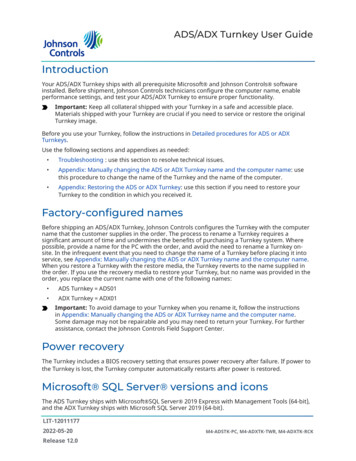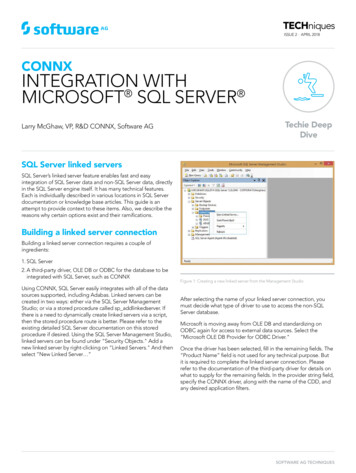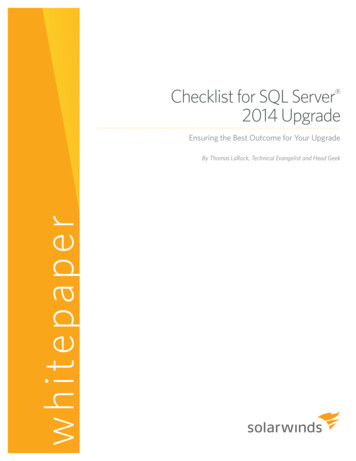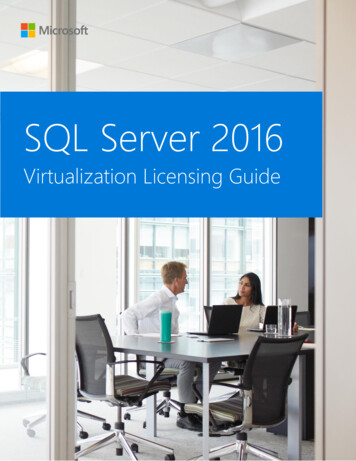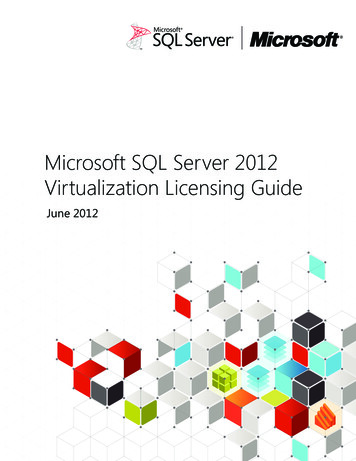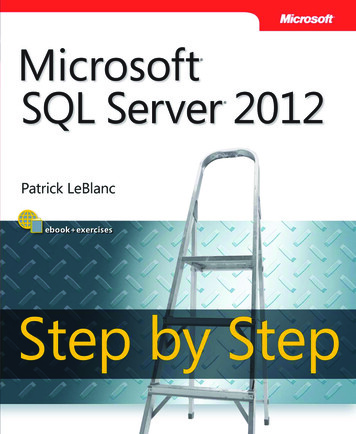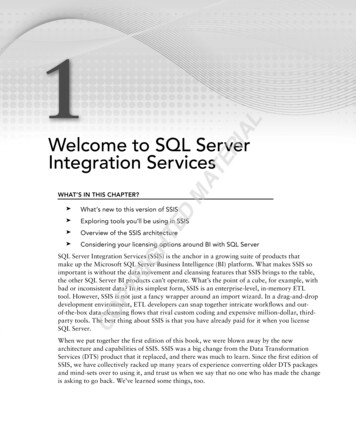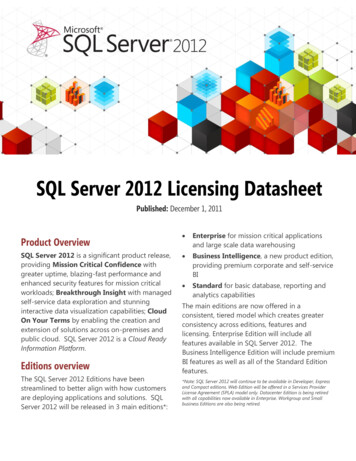
Transcription
SQL Server 2012 Licensing DatasheetPublished: December 1, 2011Product OverviewSQL Server 2012 is a significant product release,providing Mission Critical Confidence withgreater uptime, blazing-fast performance andenhanced security features for mission criticalworkloads; Breakthrough Insight with managedself-service data exploration and stunninginteractive data visualization capabilities; CloudOn Your Terms by enabling the creation andextension of solutions across on-premises andpublic cloud. SQL Server 2012 is a Cloud ReadyInformation Platform.Editions overviewThe SQL Server 2012 Editions have beenstreamlined to better align with how customersare deploying applications and solutions. SQLServer 2012 will be released in 3 main editions*: Enterprise for mission critical applicationsand large scale data warehousing Business Intelligence, a new product edition,providing premium corporate and self-serviceBI Standard for basic database, reporting andanalytics capabilitiesThe main editions are now offered in aconsistent, tiered model which creates greaterconsistency across editions, features andlicensing. Enterprise Edition will include allfeatures available in SQL Server 2012. TheBusiness Intelligence Edition will include premiumBI features as well as all of the Standard Editionfeatures.*Note: SQL Server 2012 will continue to be available in Developer, Expressand Compact editions. Web Edition will be offered in a Services ProviderLicense Agreement (SPLA) model only. Datacenter Edition is being retiredwith all capabilities now available in Enterprise. Workgroup and Smallbusiness Editions are also being retired.
SQL Server 2012 Licensing OptionsSQL Server 2012 will continue to offer twolicensing options – one based on computingpower, and one based on users or devices. In thecomputing power-based license model, however,the way we measure power will shift fromprocessors to cores. Core-based licensingprovides a more precise measure of computingpower and a more consistent licensing metricregardless of where the solution is deployedacross on-premises, virtual and cloud scenarios. Enterprise Edition (EE) will be licensed basedon compute capacity measured in cores Business Intelligence (BI) Edition will beavailable in the Server CAL model, based onusers or devices Standard Edition (SE) offers both licensingmodels to address basic database workloadsSQL Server *OptionsServer CoreOpen NL (US ) CAL BasedHigh enddatacenter, datawarehousing andBI capabilitiesMainEnterprise BI andEditions BusinessHigh ScaleIntelligenceAnalyticsStandardBasic database andBI capabilitiesClientAccessLicense(CAL)Access to SQLServer databaseslicensed per server Core based licensing is appropriate whencustomers are unable to count users/devices,have Internet/Extranet facing workloads orsystems that integrate with external facingworkloads. To license a physical server, you must licenseall the cores in the server with a minimum of 4core licenses required for each physicalprocessor in the server. Core licenses will be priced at ¼ the cost of aSQL Server 2008 R2 (EE/SE) processor license.How to license1. License all of the physical cores on the hardware2. A minimum of 4 core licenses are required perphysical processorPHYSICALCORES IN THEPROCESSOR:12468CORE LICENSESREQUIRED44468 6,874 per Core 8,592 perServer* core-based licensing. Core-based licenses willbe sold in two-core packs. 1,793 per Core,or 898 perServer*Server and Client Access License (CAL)Licensing The Business Intelligence and StandardEditions will be available under the Server andClient Access License (CAL) model. This licensing model can be used when thenumber of users can be readily counted (e.g.,internal database applications). To access a licensed SQL Server, each usermust have a SQL Server CAL that is the sameversion or newer (for example, to access aSQL Server 2008 SE server, a user would needa SQL Server 2008 or 2012 CAL). Each SQL Server CAL can provide access tomultiple licensed SQL Servers, including the 209 per CAL* Requires CALs, which are sold separately**Pricing is for demonstrative uses onlyCore-Based Licensing 2The Enterprise Edition and Standard Edition ofSQL Server 2012 will both be available under
new Business Intelligence Edition as well asStandard Edition Servers and legacyEnterprise Edition Servers. The SQL Server 2012 CAL price will increaseby about 27%.How to license1. License each individual server with a SQL Serverlicense2. License each user or device accessing the serverwith a SQL Server CALSQL Server 2012 CALs can be used to access anySQL Server database licensed per server, regardlessof platform or edition. To license a VM with core licenses, purchase acore license for each virtual core (virtualthread) allocated to the virtual machine(minimum of 4 core licenses per VM). To license a single VM with a server license(for Business Intelligence or Standard only),buy the server license and buy matching SQLServer CALs for each user. Each licensed VM covered with SoftwareAssurance (SA) can be moved frequentlywithin a server farm or to a third party hosteror cloud services provider without buyingadditional SQL Server licenses.How to License VMs with Core Licenses1. License the virtual cores in each virtual machine2. There is a minimum of 4 core licenses required foreach virtual machineVirtualization Licensing - CloudOptimizedSQL Server 2012 will offer expanded virtualizationrights, options and benefits to provide greaterflexibility for customers deploying in virtualenvironments. There will be two primaryvirtualization licensing options in SQL Server2012: The ability to license individual virtualmachines and the ability to license for maximumvirtualization in highly virtualized and privatecloud environments.Individual Virtual Machines As hardware capabilities grow, it will becomemore common for each database to use afraction of its server’s computing power. When deploying databases on VirtualMachines (VMs) that use just a fraction of aphysical server, savings can be achieved bylicensing individual VMs.3VM1VM2VM with 4 Virtual CoresVM with 6 Virtual Cores4 Core licenses required6 Core licenses requiredHow to License VMs with Server CAL1. License each VM with a Server License2. License each user or device with a CALVM1VM2VM with SQL Server BusinessIntelligence EditionVM with SQL Server StandardEdition1 Server license required CALs1 Server license required CALs
High Density Virtualization Further savings can be achieved by operatinga database server utility or SQL Server privatecloud. This is a great option for customerswho want to take advantage of the fullcomputing power of their physical servers andhave very dynamic provisioning and deprovisioning of virtual resources. Customers will be able to deploy an unlimitednumber of VM’s on the server and utilize thefull capacity of the licensed hardware. They can do so by fully licensing the server (orserver farm) with Enterprise Edition corelicenses and Software Assurance based on thetotal number of physical cores on theservers. SA then enables the ability to run anunlimited number of virtual machines tohandle dynamic workloads and fully utilize thehardware’s computing power.Licensing SQL Server private cloud:1. License all the physical cores on the server withEnterprise Edition core licenses and SA2. Deploy an unlimited number of VMsTransition to the New Licensing ModelsIn order to facilitate a smooth transition to thenew editions and licensing, Microsoft is offeringseveral options. These are designed to helpenable customers to plan for the future whileprotecting their current investments.Enterprise Edition Server CAL Licensing New server licenses for SQL ServerEnterprise Edition in the Server Calmodel will only be available for purchasethrough June 30th, 2012, after which theywill no longer be available for purchase.EA/EAP customers that buy SQL EnterpriseEdition Servers will have until their nextEA/EAP renewal after June 30th, 2012 topurchase additional server licenses tocomplete currently planned projects. Afterthat, all new SQL Server Enterprise Editiondeployments must be purchased per core. All existing SQL Server Enterprise Editionlicenses under the Server CAL model withSoftware Assurance current when SQL Server2012 launches can be upgraded to SQL Server2012 at no additional cost, and SA can bemaintained (in the server cal model) toprovide access to future software updates.These Legacy Enterprise Edition Serversremain licensed under the Server CALmodel and require the appropriate versionof the SQL Server CAL for users or devices. Legacy SQL Server 2012 Enterprise EditionServer deployments licensed in the server CAL model will be subject to a 20 core perserver license maximum. This coremaximum applies both to new server licensesand to prior version server licenses upgradedto 2012 with SA. If you purchased SQL Server2008 R2 Enterprise Edition in the Server CALmodel with Software Assurance and at theExampleWhat you LicenseWhat you DeployPhysical Cores w/EE SAUnlimited VMs (example 6)VM1Single Server, 2 physicalprocessors, 6cores/processor (12 total)VM2VM3VM4What to Buy:12 SQL Server EnterpriseEdition core licenses SAVM5VM64
launch of SQL Server 2012 are running on aserver with 20 physical cores, contact yourMicrosoft representative for help transitioningto the new licensing model. Legacy SQL Server 2012 Enterprise EditionServer licenses are still considered licensedunder the Server CAL model but have thenew core limit to allow customers to upgradetheir existing deployments and have somenear term deployment options to finishcurrently planned projects under the Server CAL model for the SQL Server EnterpriseEdition.Moving forward, customers who would havepurchased new EE server licenses can:purchase SQL BI server licenses for businessintelligence, purchase SQL EE per core forhigh-scale database or data warehouse, ormaintain legacy EE server licenses for existingprojects requiring 20 cores or less.SQL Server Processor licenses under SAmoving to Core-based Licensing Customers with processor licenses under SAcan upgrade to SQL Server 2012 at noadditional cost. At the end of the SA term,processor licenses will be exchanged for corelicenses and customers can renew their SA oncore licenses. SQL Enterprise and Standard processorlicenses under SA will be exchanged for aminimum of 4 core licenses per processor orfor the actual number of cores in use. SQLServer Datacenter processor licenses will beexchanged for a minimum of 8 EE corelicenses per processor or for the actualnumber of cores in use. At the end of the current agreement term,customers should do a self-inventory of5systems currently running SQL Server,documenting the number of cores in eachprocessor in use with a SQL Server processorlicense covered with Software Assurance. Thiswill enable customers to receive theappropriate number of core licenses based onSQL Server 2012 to continue their currentdeployments. Customers should do this self-inventory usingthe Microsoft Assessment and Planning (MAP)Toolkit or other inventory tools and processesto accurately archive a time/date stampedinventory of hardware tied to SQL Serverinstallations. If customers do not perform the selfinventory, they will receive 4 core licenses foreach Standard and Enterprise Editionprocessor and 8 EE core licenses perDatacenter Edition processor.PHYSICALCORES IN THEPROCESSOR:246810ENTERPRISE ORSTANDARD – CORESGRANTED446810DATACENTER – EECORES GRANTED888810License Transition Summary
Customers with Enterprise Agreements Customers in existing Enterprise Agreements,EAPs and EASs will be able to continue topurchase Enterprise Edition server andprocessor licenses through the end of theirterm.Customers purchasing processor basedlicenses through the end of their term willcontinue to need to calculate the number oflicenses required for a deployment based onthe 2008 R2 processor use rights. Renewing Software Assurance (SA) is the bestway to protect investments and provideaccess to new versions as well as DeploymentPlanning Services and technical assistance. EAP will continue to offer customers the bestvalue, including discounts of up to 40% onnew EE and BI server licenses. Customers should select the right editiondepending on usage:o Enterprise for mission criticalapplications and large scale datawarehousingCustomers with an EA or EAP do have theoption to add core licenses mid-term to theiragreement for future purchases and shouldcontact their reseller or Microsoft accountteam for more information. All servers licensed with SQL Server 2012Enterprise Edition server licenses will besubject to the 20 core server limitation. The same process as outlined above will befollowed at the end of term.Planning for SQL Server 2012Customers planning to deploy SQL Server 2012,either through upgrades or new licenses, shouldremember:o Business Intelligence for premiumcorporate and self-service BIo Standard for basic database, reportingand analytics capabilities Consolidation and virtualization are the bestways to maximize efficiency of hardware andcontrol the size, computing power and moregranularly manage cost of your deployments.For additional information on Microsoft SQL Server 2012, go to theSQL Server website at: http://www.microsoft.com/sqlserverThis document was developed prior to the product’s release to manufacturing, and as such, we cannot guarantee that alldetails included herein will be exactly as what is found in the shipping product. The information contained in thisdocument represents the current view of Microsoft Corporation on the issues discussed as of the date of publication.Because Microsoft must respond to changing market conditions, it should not be interpreted to be a commitment on thepart of Microsoft, and Microsoft cannot guarantee the accuracy of any information presented after the date of publication.The information represents the product at the time this document was printed and should be used for planning purposesonly. Information subject to change at any time without prior notice. 2011 Microsoft. All rights reserved.6
SQL Server 2012 Licensing Options SQL Server 2012 will continue to offer two licensing options - one based on computing power, and one based on users or devices. In the computing power-based license model, however, the way we measure power will shift from processors to cores. Core-based licensing provides a more precise measure of computing


